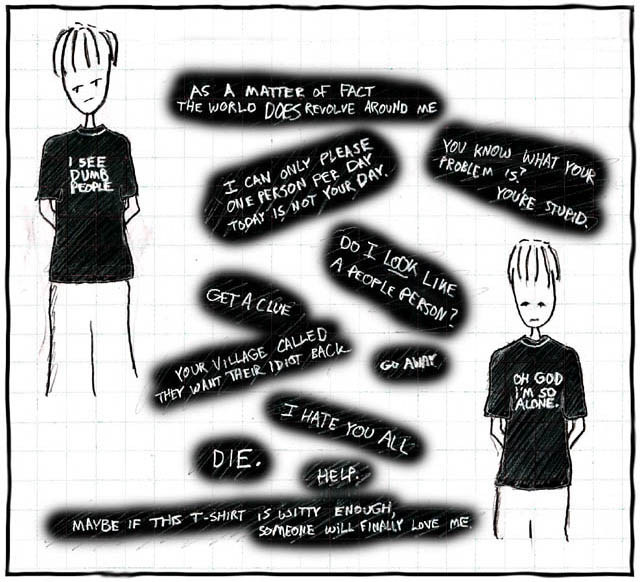When examining the current phenomenon of digitalization, it is important to remember the clarity of thought and intellectual capability that human kind once possessed. Indeed, since the
internet began gaining popularity, there has been a massive drop in--

And now for something completely different.
It’s-!
A History of Humor: the Good, the Bad, and the Ugly
by Remy Stern-Beckerman
When asked about how they feel about modern technology and the digitalization of our daily lives, most people have a clear, defined opinion on whether it has a positive or negative impact on society. Those that view it as positive make arguments about how it is aiding communication, and making information more accessible. Those that view it as negative point out that time spent interacting on the computer takes away from time spent interacting in person, which is far superior. But almost everyone agrees on one negative point: TV rots your brain. Or more specifically, digitalization is training us to use our brains less. The view does make sense. TV, computers, phones, and gaming systems are all designed to give us exactly what we want exactly when we want it: the maximum in instant gratification. And once we have found a program that we want to watch or a game we want to play, we can just sit and stare at it for hours, perhaps occasionally twitching our thumbs. It stands to reason that this life of mindless entertainment is being prompted by the new digital age, and that the availability of these devices is what makes us so committed to the pursuit of recreation above all else. But there is a fatal flaw to this argument: it’s not true. By looking at history, one can see that actually, mindless entertainment has been a priority from the beginning. The main piece of evidence for this argument comes from an unlikely source: comedy. Though the concept of humor has been around for at least as long as the human species, the idea of making someone laugh for the sake of it has absolutely no foundation in almost anything useful. By looking at some of the good (wit), the bad (slapstick), and the ugly (freakshows) elements of comedy throughout the ages and today, this paper will explore the human attitude towards recreation; and demonstrate that though digitalization makes instant gratification more accessible, humanity has always been prone to seeking out pure entertainment with no intellectual rewards when available.
While perhaps at the more intellectual end of the spectrum, witty humor still often plays into one of humanity’s most basic drives: poking fun at something. From satire of language, to satire of oneself, to satire of others, to satire of machines-- you get it. This desire to make things funny simply by pointing them out for absolutely no good reason is not some new product of the digital age. There are historical examples of witty humor at every turn. In fact, the not-so-famous first lines of Shakespeare's famous Romeo and Juliet feature a series of puns in a wholly different tone from the rest of the piece:
Sampson: Gregory, on my word, we’ll not carry coals.
Gregory: No, for then we should be coalliers.
Sampson: I mean, an we be in choler, we’ll draw.
Gregory: Ay, while you live, draw your neck out of collar. (Shakespeare 1-2)
And so on. While this makes almost no sense to the average reader today because of the change in language since the play’s original publication around 1595, such language barriers also serve to show just how universal the material is. The business of grammatical humor is still alive and well, as the existence of websites like “Pun of the Day” ("Pun of the Day") demonstrate. If you are in the mood for a pun, there is no doubt that it is easier to log on to that website and look them up than read an entire play, but the desire to be entertained by a grammatical loophole has not changed since the days of Shakespeare (and indeed, probably long before). What draws us to wit is not only the desire to be smarter than the next guy, but also to be more likable. This is one of the basic desires of the average human, and something completely universal. This is a point backed by not only the existence of XKCD.com (“a webcomic of romance, sarcasm, math, and language”) but also spectacularly demonstrated by their popular comic T-Shirts (right).("T-Shirts")  Wit is an enduring part of human culture, spanning the globe and the ages, unrelated to the recent influx of technology. But Remy, you might say, wit is somewhat useful. Because of its satirical nature, witty humor can be used as a means of social commentary. Silly reader, I wasn’t talking about that usage. But as long as you’ve brought it up, we might as well move on to a less high-brow brand of humor...
Wit is an enduring part of human culture, spanning the globe and the ages, unrelated to the recent influx of technology. But Remy, you might say, wit is somewhat useful. Because of its satirical nature, witty humor can be used as a means of social commentary. Silly reader, I wasn’t talking about that usage. But as long as you’ve brought it up, we might as well move on to a less high-brow brand of humor...
If wit is the intellectual of the family, slapstick is the crazy aunt with lipstick in colors that no one’s ever heard of. Commonly regarded to as one of the lowest forms of humor, slapstick is also one of the most basic. Relying entirely on the concept of catastrophic physical failure often combined with odd or ironic timing, slapstick has its roots in the undeniable realities of life. While slapstick comedy has probably been around since a few minutes after the evolution of a brain region responsible for processing humor, the actual term comes from the English name for a special paddle used in physical comedy routines in the 1500s commedia dell’arte to produce a loud noise while doing very little damage. ("Slapstick (comedy)") Slapstick humor can be dated as having begun earlier than there are written records of, as it played a large role in Greco-Roman mime, some of which dates back to the fifth century B.C. (“Mime and Pantomime”) When put in this context slapstick is easily identifiable as one of the earliest historical examples of mindless entertainment, but this often escapes notice when criticizing one of the top digital sources of mindless entertainment: the funny home video. Slapstick reigns supreme on Youtube, as the examples provided show. ("Grape lady falls!") (right, 4,358,055 views) (“100 funny falls”) (left, 2,376,176 views)
(“100 funny falls”) (left, 2,376,176 views)  While the medium has changed, the act of watching it is still fulfilling the same basic desire to see people fall down (a form of entertainment with absolutely no use whatsoever, or indeed any rational explanation as to what makes it funny in the first place). Perhaps, you might cut in, we are engaged by the pure strangeness of the event. Nay, I would say in such a situation, that is what our next form of entertainment is for.
While the medium has changed, the act of watching it is still fulfilling the same basic desire to see people fall down (a form of entertainment with absolutely no use whatsoever, or indeed any rational explanation as to what makes it funny in the first place). Perhaps, you might cut in, we are engaged by the pure strangeness of the event. Nay, I would say in such a situation, that is what our next form of entertainment is for.
While not strictly a form of comedy, the freakshow is still one of the most popular historical forms of entertainment. While viewers may initially become interested because of their curiosity and not just for fits and giggles, that curiosity does not translate into desire to learn more about the uncanny attraction. Rather, the viewer is prompted to want to see more, a fact capitalized upon by many a traveling showman. While the sideshow was popularized in the early 1800s, Lazarus Colloredo ("Lazarus and Joannes Baptista Colloredo") (right) toured around Europe showing off his parasitic brother John Baptista in one of the earliest recorded novelty acts in the 1630s. ("Book Rags") The pursuit of all things weird and wondrous can also be recognized as one of the historical elements of entertainment carrying through to the mindless entertainment thought of as a product of digitalization. Like slapstick, the exhibition of things unusual or extreme has found an audience in videos, as demonstrated by the two examples, ("Funny Weird and cool Hairstyles") (left, 15,856 views)
toured around Europe showing off his parasitic brother John Baptista in one of the earliest recorded novelty acts in the 1630s. ("Book Rags") The pursuit of all things weird and wondrous can also be recognized as one of the historical elements of entertainment carrying through to the mindless entertainment thought of as a product of digitalization. Like slapstick, the exhibition of things unusual or extreme has found an audience in videos, as demonstrated by the two examples, ("Funny Weird and cool Hairstyles") (left, 15,856 views) ("charlie schmidt's "cool cat"") (right, 3,833,102 views)
("charlie schmidt's "cool cat"") (right, 3,833,102 views)  but in this case it’s not the video that makes the show: it’s the cat. In the exhibition of all things visually questionable, cats have become the new stars, stepping in now that the freakshow has become morally objectionable. The same curiosity that led Victorians to seek out “freaks of nature” before it was recognized as offensive has created stars like ceilingcat, monorail cat, cheezburger cat, ("I Can Has Cheezburger?") and countless others. Something may seem wrong about sitting and staring at cats for hours, but the change in media is the only difference in mental stimulation between the two displays.
but in this case it’s not the video that makes the show: it’s the cat. In the exhibition of all things visually questionable, cats have become the new stars, stepping in now that the freakshow has become morally objectionable. The same curiosity that led Victorians to seek out “freaks of nature” before it was recognized as offensive has created stars like ceilingcat, monorail cat, cheezburger cat, ("I Can Has Cheezburger?") and countless others. Something may seem wrong about sitting and staring at cats for hours, but the change in media is the only difference in mental stimulation between the two displays.
But Remy! You may interject. These videos have millions upon millions of views! People are just sitting at home for hours doing nothing but watching funny videos or looking at pictures of cats! Surely this must be the laziest era in human history, and it’s all due to digitalization! I’m glad you brought that up, reader. Allow me to direct your attention to an even lazier lifestyle: that of the Noble. Almost anywhere in history with distinctly defined upper and lower classes and a large gap between them, the upper class has lived a life of leisure and luxury at the expense of the lower class. From ancient Rome (Marcellinus) to 1600s England (Peck 14), examples of a life of luxury being led by those that could afford it are abundant no matter the time period investigated. Perhaps the strongest example comes from pre-revolution France, otherwise known as the Rococo era. Here, the nobility lived a life of luxury and whimsy, devoting their ridiculous wealth and power to the pursuit of recreation and romance while 97% of the population starved in the streets. ("Smarthistory") Ignorant, more interested in entertaining themselves than learning about the world around them? Yes. Prompted by digitalization? No.
So there you have it. From wit to slapstick, freakshows to sheer ignorant bliss, people have always sought out mindless entertainment when available. The current tendency toward recreation is no different than the essential human preference that has prevailed throughout history. So why do we blame technology? Perhaps the reason is simply because digitalization is a new phenomenon. Human society has always had a nack for condemning change, despite also specializing in causing it. For example, as the automobile first became popular, it was thought of as so dangerous that Britain passed a law requiring the vehicle to be preceded by a man on foot waving a red flag and blowing a horn at all times. ("Random History") Perhaps we wanted a scapegoat for our own behavior. Whatever the reason, it seems that it is in our very nature to deny our very nature.
Works cited:
Shakespeare, William. Romeo and Juliet. Washington Square Press ed. USA: Pocket Books, 1972. 1-2. Print.
"Funniest Puns." Pun of the Day. 01 Nov 2009. Web. 8 Nov 2009.
"T-Shirts." XKCD.com. Web. 2 Nov 2009.
"slapstick." Encyclopædia Britannica. 2009. Encyclopædia Britannica Online. 01 Nov. 2009
"mime and pantomime." Encyclopædia Britannica. 2009. Encyclopædia Britannica Online. 08 Nov. 2009
"Grape lady falls!." Web. 1 Nov 2009.
"100 funny falls" Web. 1 Nov 2009.
"Freak show Summary." Book Rags. Web. 8 Nov 2009.
"Lazarus and Joannes Baptista Colloredo." Web. 8 Nov 2009.
"Funny Weird and cool Hairstyles." 8 Nov 2009. Web.
"charlie schmidt’s “cool cat”" 8 Nov 2009. Web.
"Lolcats 'n' Funny Pictures of Cats." I Can Has Cheezburger?. Web. 8 Nov 2009.
Marcellinus, Ammianus. "Ammianus Marcellinus (c.330-395 CE): History, XIV.16: The Luxury of the Rich in Rome, c. 400 CE. ." Ancient History Sourcebook. Ancient History Sourcebook, Web. 8 Nov 2009.
Peck, Linda Levy. Consuming splendor: society and culture in seventeenth-century England. USA: Cambridge University Press, 2005. 14. Print.
"Rococo." Smarthistory. Smarthistory, Web. 8 Nov 2009.
"The History of the Car." Random History. Random History, Web. 8 Nov 2009.
No comments:
Post a Comment